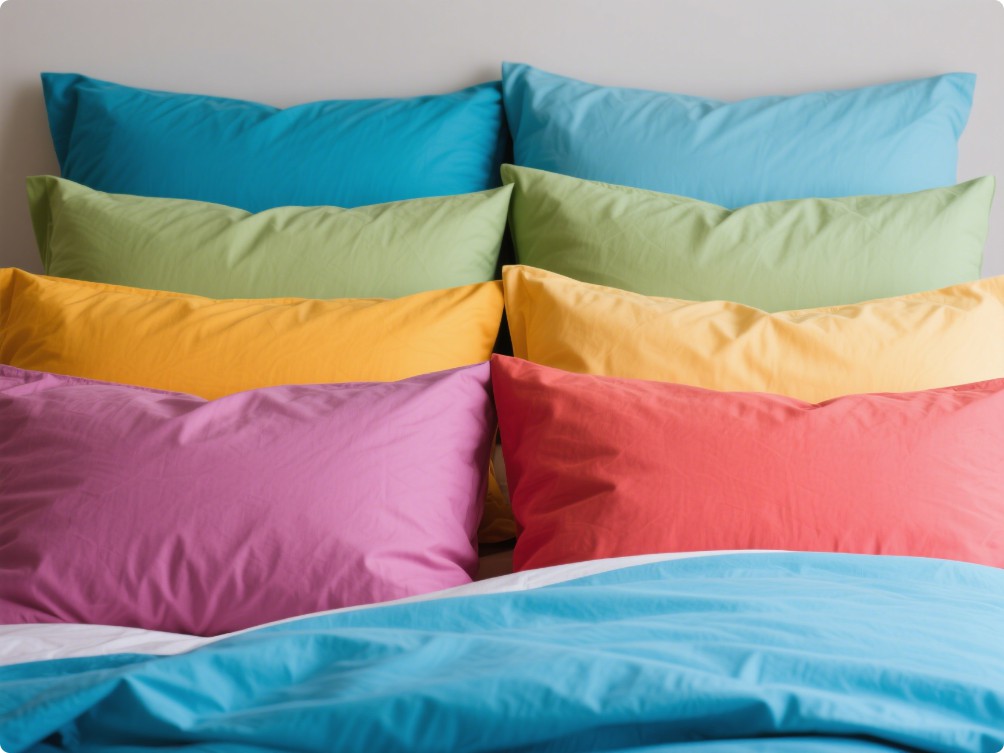Lena always believed that the most important part of her day was what she did when the sun set. By nightfall, the weight of the world seemed to fall off her shoulders, and all she craved was a peaceful retreat, a soft corner where she could finally breathe. But even though her bed was comfortable, something always felt… off. She couldn’t quite put her finger on it, but the rest she sought never quite reached her. Sleep didn’t come as easily as it should.
One evening, after tossing and turning longer than she would have liked, Lena sat up in bed, her eyes scanning her room. Her walls were a calm, neutral tone — nothing too bold, nothing too bright. Yet, somehow, the room never felt as soothing as she’d imagined. Her sheets, a basic shade of gray, didn’t seem to invite her to relax. The duvet, though soft, was heavy, and the pillows, stacked high but without purpose, felt uninviting.
It was then that Lena remembered something she had once read: the way color affects mood. The way hues could influence not just how a room looked, but how it made you feel.
Curious, she started looking deeper. The more she learned about color psychology, the more she realized how deeply shades could affect her mind and body. Colors weren’t just aesthetic choices — they were emotional cues, and perhaps that was the missing piece of her restful puzzle.

Lena decided to experiment. The first change she made was simple: her sheets. She chose soft blues — the kind that reminded her of deep ocean waters and endless skies. That night, as she slipped into bed, something shifted. She felt lighter, as though the deep tones of the blue were wrapping around her like a calm, cooling breath. She slept soundly, uninterrupted for the first time in weeks. Blue, it seemed, wasn’t just pretty to look at; it was deeply calming. It soothed her mind, making her feel safe and at peace.
Inspired by her success with the blue sheets, Lena began to experiment further. She swapped her duvet cover for a soft green one, the shade of spring mornings when the grass was wet with dew. She learned that green was a color associated with harmony and balance, a shade known to relax both the body and mind. That night, she fell into a deeper sleep than she had in ages, feeling as though the world outside her window had softened. Green wasn’t just a color — it felt like a fresh breeze, like the earth was cradling her gently, inviting her to let go.
As she discovered the colors that best suited her mood, Lena learned the delicate dance between warmth and coolness. She found that warmer shades, like soft oranges and rich reds, made her feel energized, but not always relaxed enough for sleep. The warmth in these colors reminded her of sunlight and fiery moments, stimulating her senses and keeping her alert. While lovely during the day, they weren’t what she needed when the moon rose.
After her experiments with color, Lena’s bedroom became a sanctuary in a way she hadn’t anticipated. The colors were no longer simply part of the room’s design. They became her companions, silently guiding her into the perfect night’s rest. The deep blues lulled her into relaxation. The calming greens settled her restless mind. The soft neutrals—like gentle beige and ivory—remained constant, providing a steady foundation.
Over time, Lena came to understand that sleep wasn’t just about comfort; it was about creating an atmosphere that invited serenity. It wasn’t just about slipping into bed — it was about creating a space that felt right, from the sheets to the pillows to the room’s very soul.
One quiet morning, as she sipped tea in her room, sunlight streaming through the window, Lena realized how profoundly colors had changed her experience of rest. They had helped her build a ritual, a sense of tranquility that she could now rely on. No longer was she restless; the color of her bedding had quietly transformed her mood and, in turn, her quality of sleep.
She learned, in the most subtle way, that the colors we choose for our lives — the things we wrap ourselves in, the spaces we surround ourselves with — aren’t just decor. They shape us. They influence our moods and our minds. And sometimes, the right shade is the key to finding the peace we’ve been looking for.
And as Lena sank into her bed that evening, surrounded by soft blues and greens, she finally understood: color, like sleep, isn’t something you chase. It’s something you create — softly, deliberately, with care.
